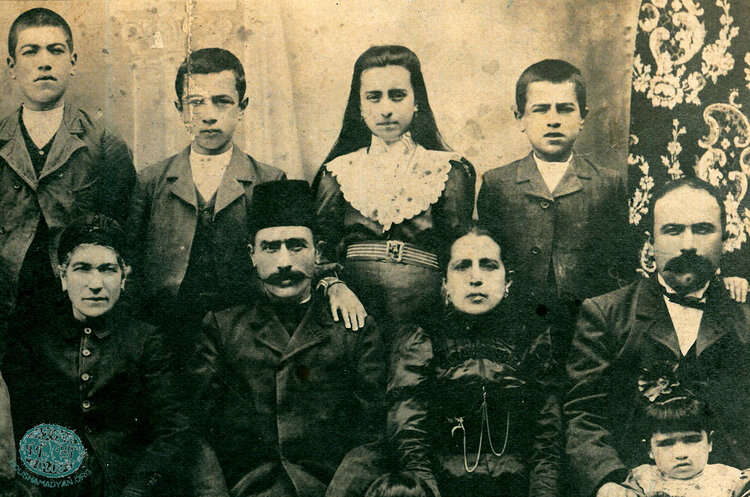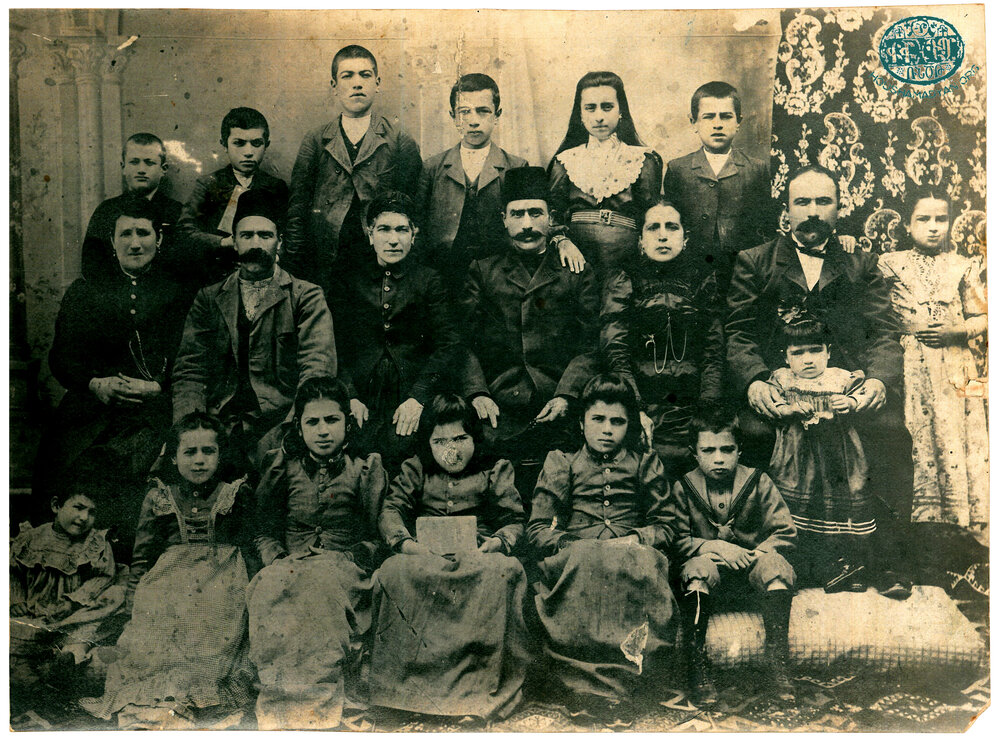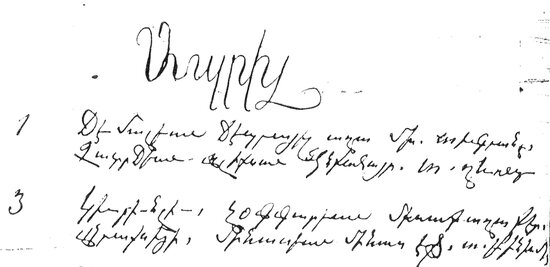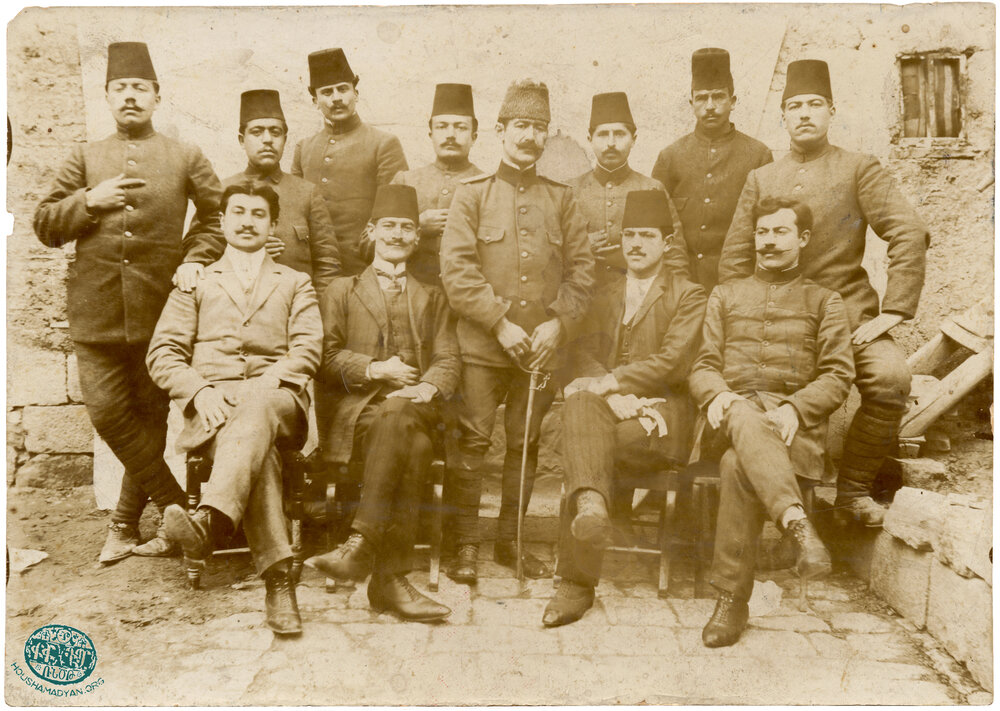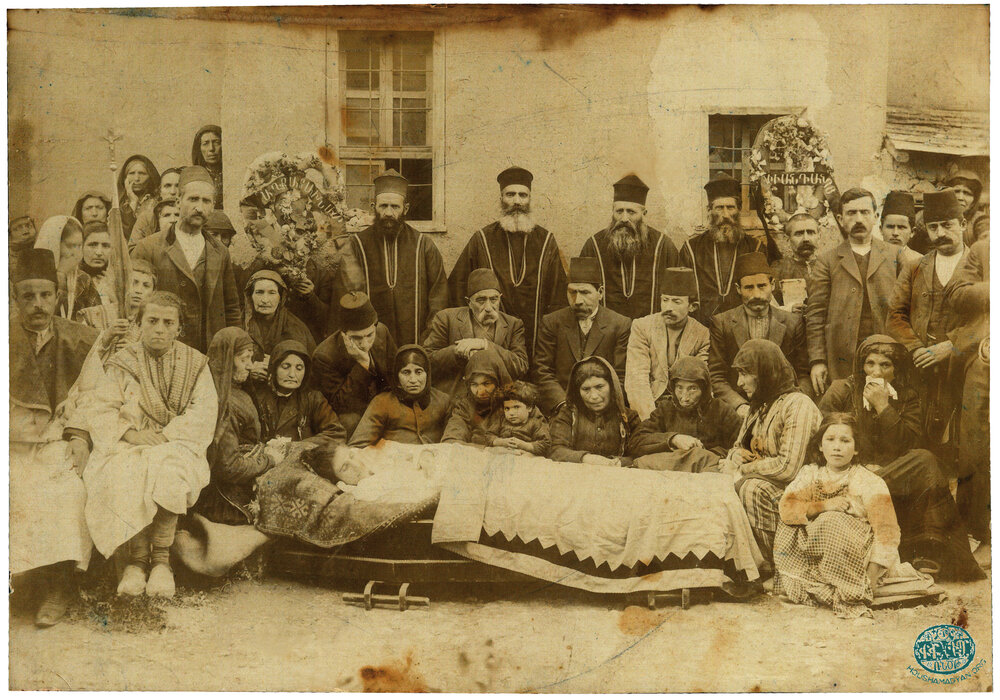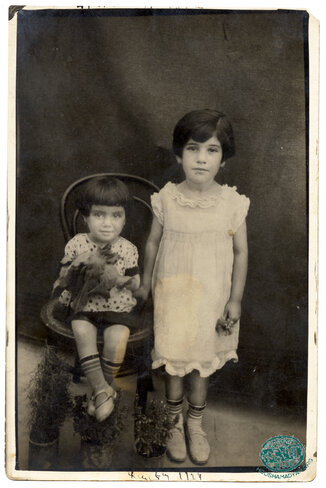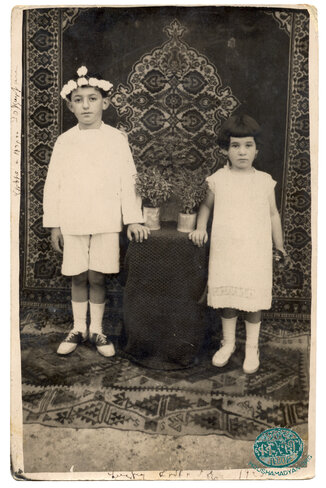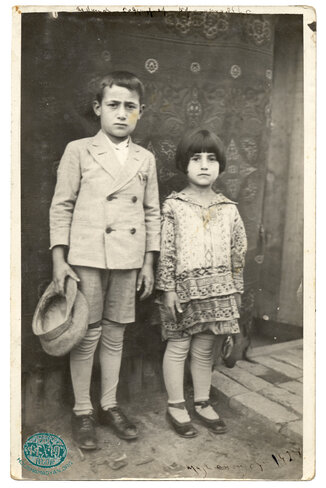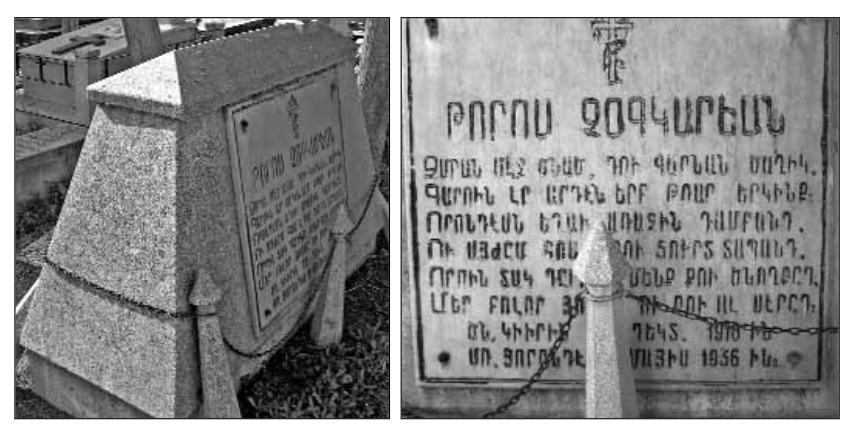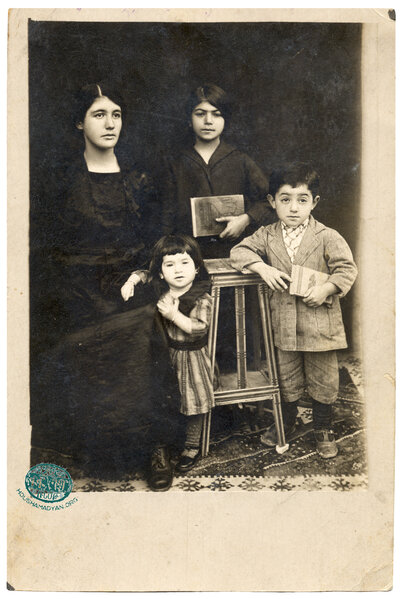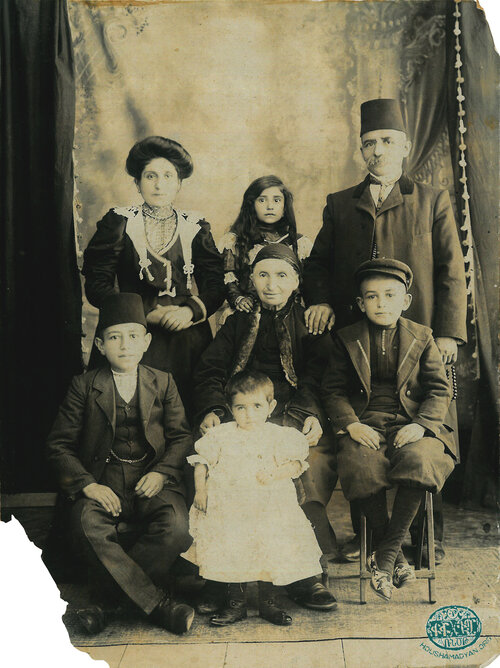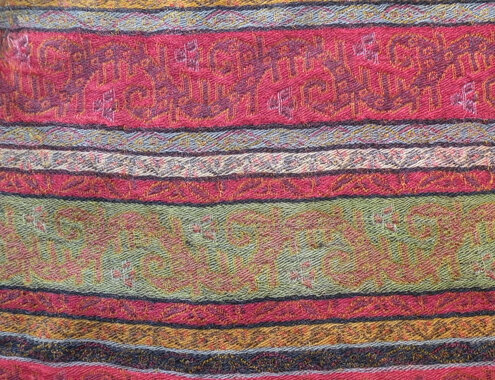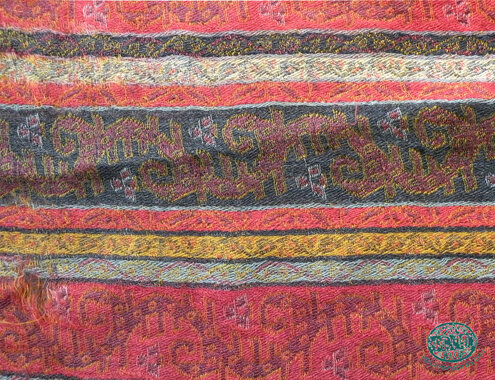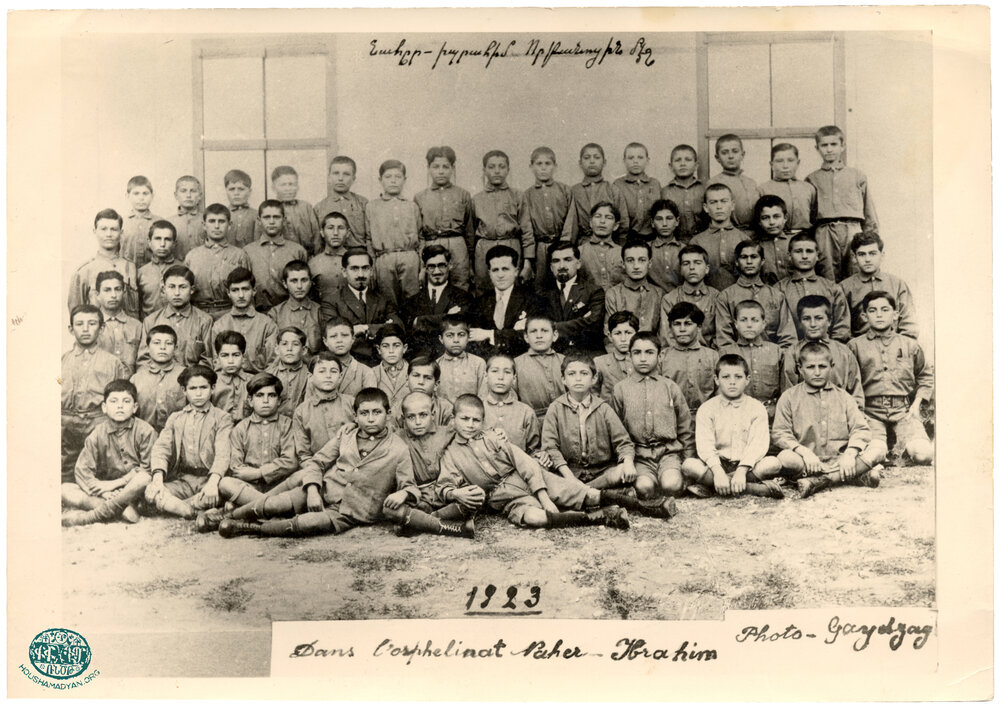Chokgarian collection - Yerevan

This collection of photographs belongs to the Chokgarian family originally from Gürün (Gurin). From the forefathers of the Chokgarian family, we can identify the four brothers: Setrag, Gabriel, Misak and Hapet. The 1828 census of the parishes in Gürün already contains a Mahdesi Kapriel Chokar, who was surely one of the family’s forefathers. This census was published in one of the works of the Mekhitarist scholar Father Sahag Vartabed Jemjemian (Gurini Housher, no 7, January 1980, New Jersey, p. 88).
The Chokgarian family was in the shawl making business - they produced and sold scarves. The production of scarves was a famous trade in Gürün, and it was exported to different places outside the city. We know that Setrag and Gabriel continued to live in Gürün and were prominent figures in the Armenian community, while Misak had later settled in Kayseri/Gesaria, and their fourth brother Hapet in Konya.
Setrag married Baydzar and they had three children: Roupen, Vartouhi, and Mary. Gabriel married Jouhar and they had five children: Toros, Haroutyoun, Zmroukhd, Armenouhi, and Sara. Misak married Santoukhd and they had six children: Youghaper, Mihran, Haygaz, Haygouhi, Araksi, and Onnig. Hapet who lived in Konya married Hayganoush Moughalian and they had four children: Vartouhi, Vergine, Avedis, and Vahram. Avedis died and was buried in Aleppo while the rest of the family continued their journey and settled in Lebanon.
We know that the shawl making business that Misak had developed was very successful; Misak had settled in Kayseri/Gesaria and at the time his business also had branches in Adana, Konya and Aleppo [1].
Here our focus will be on Haroutyoun, the son of Gabriel and Jouhar. Haroutyoun was born in 1892 and later married Karentsa, who was born in 1897. They had four children: Toros (born in 1919), Vergine (born in 1921), Seta (born in 1938), and Zmroukhd (born in 1926, but died at the age of two after being infected with measles).
It is Haroutyoun and Karentsa’s daughter Seta Tombalian (born Chokgarian) who put these photographs at Houshamadyan’s disposal; Seta was born in Aleppo and continued to live there until recently. She moved to Armenia not long ago, she currently keeps the family’s photographs with her in Yerevan. Seta Chokgarian was married to Tombalian (variably spelled Toumbalian/Tyoumbalian) who was also a Gürün descendant.
The Chokgarian family, Gürün, around 1902.
Standing from left to right are: Roupen, Haroutyoun, Toros, Mihran, Youghaper, and Haigaz. In the middle row, sitting from left to right are: Baydzar, Setrag, Jouhar, Gabriel, Santoukhd, Misak, Araksi (the little girl standing, she has Misak’s arms around her), and Haygouhi. First row, sitting from left to right are: Mary, Vartouhi, Sara, Armenouhi, Zmroukhd, and Onnig.
During these years, Misak had already settled in Kayseri/Gesaria, and on the occasion of his family’s visit to Gürün, the whole family had posed for this photograph.

Two of Misak's children were baptized at the St Krikor Lusavorich church of Kayseri/Gesaria between 1902 and 1915. The first was Araksi; here is an image of the baptism record. The baptism was on 3 April 1903 and it reads: Araksi, daughter of Misak agha Chokarian of Gürün, Minas effendi Minasian was the godfather, Der Peniamin was the officiating priest.
The second baptism record is for Nartouhi's baptism from 1 March 1907, she is the daughter of Misak agha Chokarian of Gürün, Minas agha Minasian was the godfather and Der Peniamin was the officiating priest.
Here we can see the baptism records in Aleppo. All 3 children, Toros (born on 10 December 1918), Vergine (born on 14 February 1920), and Elmast (born on 8 August 1926) were baptized in Aleppo on the same day: 5 December 1926. The officiating priest was Der Krikor Khachadourian for all 3 and the godfather was Souren Chokgarian. The parents are listed as Haroutyoun Chokgarian (merchant) of Gürün and Karentsa.

Sara’s funeral in Sivas/Sepasdia, around 1910. Sara is Gabriel and Jouhar Chokgarians’ daughter. She had married and moved from Gürün to Sivas, where she passed away. We can see the mother of the deceased, Jouhar, behind the coffin, among the women in mourning all wearing black. Jouhar is holding a child in her arms; this is Sara’s child. We can also see Gabriel sitting behind them, a bit diagonally, slightly to the right. The flower wreaths in the back have the following written on them in Armenian: “Aghkadakhnam”, meaning charity (the one on the left) and “Hivantanots” meaning hospital on the right.

1) Aleppo, 1927. Vergine (on the right) and her little sister, Zmroukhd, (on the left), who was born in 1926 and died when she was two years old after getting measles.
2) Aleppo, 1925. Toros (on the left) and Vergine Chokgarian. They are photographed on the occasion of Toros receiving his kindergarten diploma. We know that in 1925, Haroutyoun and Karentsa Chokgarian had already settled in Aleppo.
Later, Toros would often go to Iskenderoun (currently Turkey, which was part of Syria at the time). In the 1930’s, during a business trip, Toros and his 2 friends went for a swim in the Asi (Orontes) River; Toros drowned, he was only 17 years old. A few years after this tragedy, in 1938, Seta was born.
3) 1928, Buenos Aires. These are the grandchildren of Roupen – the son of Setrag and Baydzar Chokgarian. Their father’s name is Shmavon Chokgarian.

Toros Chokgarian's (1918-1936) tombstone in the Armenian cemetery in Aleppo. The writing is from Archbishop Ardavast Sourmeian, the Armenian prelate of Aleppo at the time. It reads:
Toros Chokgarian
A spring flower born in winter
It was already spring when you flew to the sky
You first tomb was in Orontes
And now here is your cold grave
Where we your parents have placed
All our hope and your love
Born in Gürün, on 22 December 1918
Died in Orontes, on 11 May 1936.
(The source of the photograph: Raffi Kortoshian, The Inscriptions of Aleppo, RAA publishing, Yerevan, 2013)
Photographed around 1922, probably in Gürün. From left to right are: Karentsa, Vergine (the little girl leaning on her mother’s lap, born in 1921), Sirarpi, Toros (born in 1919). Vergine and Toros are Karentsa and Haroutyoun’s children. Sirarpi is the daughter of Haroutyoun Chokgarian’s sister Zmroukhd.
It is a post-Genocide era photograph – during the previous years, the Chokgarian family like all Armenians in Gürün, had lived the horror of atrocities, exile and abduction. Sirarpi and Karentsa were survivors. Sirarpi was forced into marriage with a Turk during the years of war. Later, Karentsa and Haroutyoun were the ones who took her under their roof.
During the Genocide, Haroutyoun got arrested and they threatened to kill him. However, he managed to escape from prison, and lived in hiding in Sivas during the whole of those years. After ceasefire, he returned to Gürün, where surviving members of his family had also probably gathered. In 1921, he got enlisted in the Mustafa Kemal army and served for about 4 years. In 1925, he moved to Aleppo. It is assumed that during that time Karentsa and the children were still living in Gürün. However, in the same year the family also moved to Aleppo and a new life started for them in this Syrian city.


An example of the famous scarves from Gürün (66 cm x 90 cm).
Manuel Afarian (date of birth unknown, died in 1962) is the one who made this shawl; he was born in Gürün and was a shawl maker by profession. Manuel later moved to Adana, where he continued his profession. At the end of WWI, Manuel first settled in Damascus, and later in the 1903’s, he moved to Lebanon with his family, they settled in the seaside neighborhood of Karantina (La Quarantaine). In the 1960’s, they finally moved to the Armenian neighborhood of Bourj-Hammoud. The Afarian family kept this shawl with them in Lebanon for many years, it is currently part of Houshamadyan’s collection.

The Armenian orphans of the Near East Relief American association’s Nahr Ibrahim (Lebanon) orphanage, 1923. In the second row from the bottom, the 4th from the right is Benjamin Minassian (with thick black hair). Benjamin would later marry Seta’s sister Vergine. We know that this orphanage was founded in 1923 in the north of Beirut, when Armenian orphans from Konya and Kayseri/Gesaria reached Lebanon. Stanely Kerr was the American director of the orphanage. Around 1000 orphans had found refuge in this orphanage. When malaria hit the institution, the outcome was disastrous; the orphans got infected and dozens of them died, while the approximately 400 orphans moved to the American orphanage in Jbeil a bit further to the north, in 1924.

